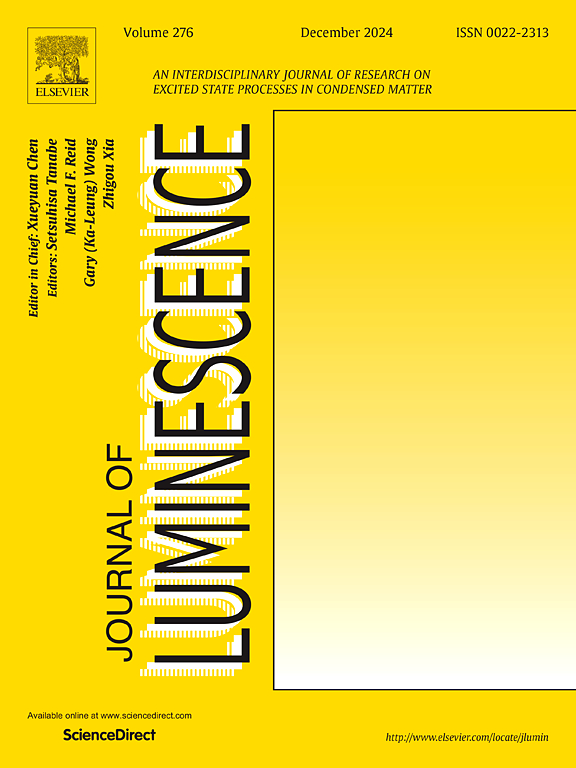Circularly polarized red luminescence based on new enantiopure menthol-functionalized tris-β-diketonate-Eu3+ binary complexes
IF 3.3
3区 物理与天体物理
Q2 OPTICS
引用次数: 0
Abstract
Aromatic 1,10-phenanthroline (Phen) derivatives have been extensively utilized as N^N-ancillary co-ligands in achiral tris-β-diketonate-Eu3+ binary complexes with efficient pure red-light. However, circularly polarized (CP) red-light of chiral tris-β-diketonate-Eu3+ binary complexes assembled from chiral Phen-derivatives, has never been reported. Herein, based on the synthesized menthol-substituted (at the 5-position) enantiopure Phen-derivative (D-Phen or L-Phen), two new chiral tris-β-diketonate-Eu3+ binary complexes [Eu(tta)3(D-Phen)] (1) and [Eu(tta)3(L-phen)] (3) (Htta = 2-thenoyltrifluoroacetone) are obtained. The two Eu3+ enantiomers can exhibit the bright high-purity red-light (ΦPL = 65–66 %) in combination with the detectable CPL signal (|glum| ≈ 0.01 at 5D0→7F1). This study engenders chiral tris-β-diketonate-Eu3+ binary complexes (such as [Eu(O^O)3(chiral-Phen)] et al.) a new platform forward to efficient chiroptical organo-Eu3+ compounds.

基于新型对映纯薄荷醇功能化三-β-二酮酸- eu3 +二元配合物的圆偏振红发光
芳香的1,10-邻菲罗啉(Phen)衍生物在高效纯红光下作为N^N辅助配体广泛应用于非手性三β二酮- eu3 +二元配合物中。然而,手性苯基衍生物组装的三β二酮- eu3 +二元手性配合物的圆偏振红光尚未见报道。本文以合成的薄荷醇取代(5位)对映纯苯衍生物(D-Phen或L-Phen)为基础,得到了两个新的手性三β-二酮- eu3 +二元配合物[Eu(tta)3(D-Phen)](1)和[Eu(tta)3(L-Phen)] (3) (Htta = 2- thenoyltrifluoro丙酮)。两种Eu3+对映体结合可检测到的CPL信号(在5D0→7F1下|glum|≈0.01),显示出明亮的高纯度红光(ΦPL = 65 ~ 66%)。本研究产生了手性三β-二酮酸- eu3 +二元配合物(如[Eu(O^O)3(chiral- phen)]等),为高效手性有机eu3 +化合物提供了新的平台。
本文章由计算机程序翻译,如有差异,请以英文原文为准。
求助全文
约1分钟内获得全文
求助全文
来源期刊

Journal of Luminescence
物理-光学
CiteScore
6.70
自引率
13.90%
发文量
850
审稿时长
3.8 months
期刊介绍:
The purpose of the Journal of Luminescence is to provide a means of communication between scientists in different disciplines who share a common interest in the electronic excited states of molecular, ionic and covalent systems, whether crystalline, amorphous, or liquid.
We invite original papers and reviews on such subjects as: exciton and polariton dynamics, dynamics of localized excited states, energy and charge transport in ordered and disordered systems, radiative and non-radiative recombination, relaxation processes, vibronic interactions in electronic excited states, photochemistry in condensed systems, excited state resonance, double resonance, spin dynamics, selective excitation spectroscopy, hole burning, coherent processes in excited states, (e.g. coherent optical transients, photon echoes, transient gratings), multiphoton processes, optical bistability, photochromism, and new techniques for the study of excited states. This list is not intended to be exhaustive. Papers in the traditional areas of optical spectroscopy (absorption, MCD, luminescence, Raman scattering) are welcome. Papers on applications (phosphors, scintillators, electro- and cathodo-luminescence, radiography, bioimaging, solar energy, energy conversion, etc.) are also welcome if they present results of scientific, rather than only technological interest. However, papers containing purely theoretical results, not related to phenomena in the excited states, as well as papers using luminescence spectroscopy to perform routine analytical chemistry or biochemistry procedures, are outside the scope of the journal. Some exceptions will be possible at the discretion of the editors.
 求助内容:
求助内容: 应助结果提醒方式:
应助结果提醒方式:


